The Cambridge History of China. Vol. 13: Republican China 1912-1949, Part 2
Подождите немного. Документ загружается.

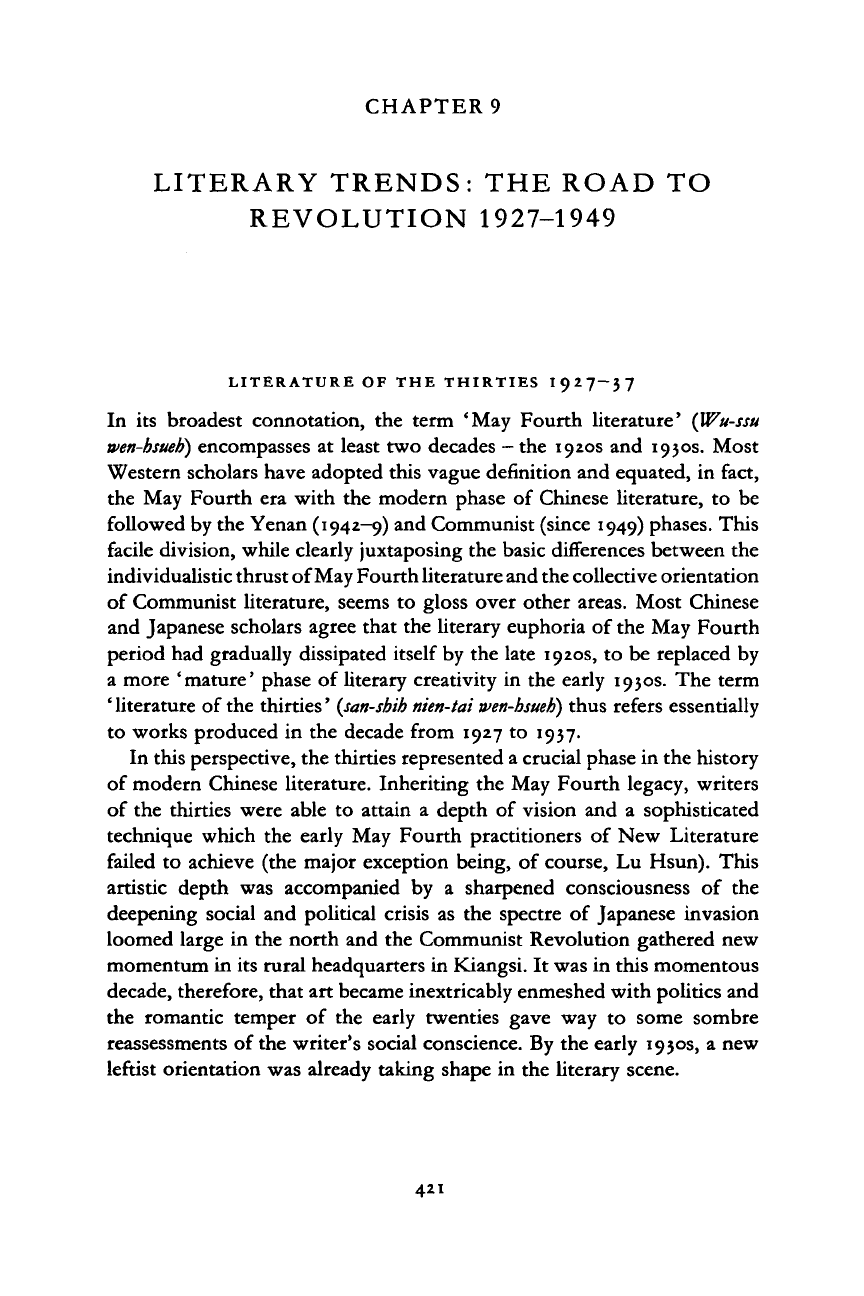
CHAPTER
9
LITERARY TRENDS:
THE
ROAD
TO
REVOLUTION 1927-1949
LITERATURE OF THE THIRTIES I927-37
In
its
broadest connotation,
the
term 'May Fourth literature' (Wu-ssu
wen-hsueh)
encompasses
at
least two decades
-
the 1920s and 1930s. Most
Western scholars have adopted this vague definition and equated, in fact,
the May Fourth era with the modern phase
of
Chinese literature,
to be
followed by the Yenan (1942-9) and Communist (since 1949) phases. This
facile division, while clearly juxtaposing the basic differences between the
individualistic thrust of May Fourth literature and the collective orientation
of Communist literature, seems
to
gloss over other areas. Most Chinese
and Japanese scholars agree that the literary euphoria of the May Fourth
period had gradually dissipated itself by the late 1920s,
to
be replaced by
a more 'mature' phase
of
literary creativity
in
the early 1930s. The term
'literature of the thirties'
{san-shih nien-tai wen-hsueh)
thus refers essentially
to works produced
in
the decade from 1927
to
1937.
In this perspective, the thirties represented a crucial phase in the history
of modern Chinese literature. Inheriting the May Fourth legacy, writers
of the thirties were able
to
attain
a
depth
of
vision and
a
sophisticated
technique which
the
early May Fourth practitioners
of
New Literature
failed
to
achieve (the major exception being,
of
course,
Lu
Hsun). This
artistic depth
was
accompanied
by a
sharpened consciousness
of the
deepening social and political crisis
as the
spectre
of
Japanese invasion
loomed large
in
the north and the Communist Revolution gathered new
momentum in its rural headquarters in Kiangsi.
It
was in this momentous
decade, therefore, that art became inextricably enmeshed with politics and
the romantic temper
of
the
early twenties gave
way
to
some sombre
reassessments
of
the writer's social conscience. By the early 1930s,
a
new
leftist orientation was already taking shape
in
the literary scene.
421
Cambridge Histories Online © Cambridge University Press, 2008

422 LITERARY TRENDS
From literary
revolution
to
revolutionary
literature
The impact of the May Thirtieth incident on the political sensibilities of
modern Chinese writers was immense.
1
It triggered a shock of recognition
among many of them and opened their eyes to the 'imperialistic' presence
of the Western powers and
to
the plight
of
workers who lived with
it,
side
by
side,
in
the commercial metropolis
of
Shanghai.
A
process
of
politicization was
set in
motion
as
most writers' sympathies gradually
drifted toward
the
left. Most literary historians agree that
the
May
Thirtieth incident marked
a
crucial turning point: modern Chinese
literature moved,
in
the memorable phrase
of
Ch'eng Fang-wu, from
' literary revolution'
to
' revolutionary literature'.
For years before the incident occurred, a few groping attempts to relate
literature
to
politics
and
revolution
had
been made.
In
1923, some
members of the newly founded Chinese Communist Party, notably Teng
Chung-hsia
and Yun
Tai-ying
in
their journal
Chung-kuo ch'ing-nien
(Chinese youth), argued that literature should
be
used
as a
weapon
to
arouse people's revolutionary consciousness.
2
In
1924 and 1925, Chiang
Kuang-tz'u,
a
young Communist writer who
had
just returned from
Russia, published two articles: 'Proletarian revolution and culture' and
'Contemporary Chinese society and revolutionary literature'. Both Kuo
Mo-jo and Yii Ta-fu used terms such
as
'proletarian spirit' and 'class
struggle' in their articles published in 1923.
In
1925 Lu Hsun sponsored
the publication
of
a translated text called Literary
debates
in
Soviet
Russia
(Su-e wen-i lun-chari)
by the Unnamed Society (Wei-ming she)
in
Peking,
and thereafter avidly followed the rapid shifts
of
Soviet literary policy.
These isolated efforts, however, did not create much stir until the impact
of
the May
Thirtieth incident brought
the
issue
of
literature
and
revolution to the fore. The leftist trend was again set by members of the
Creation Society, particularly Kuo Mo-jo. Kuo claimed
to
have been
converted to Marxism
in
1924 after having read
a
book by the Japanese
Marxist Kawakami Hajime.
In
1926, he wrote what is now regarded
as
the manifesto
of
the revolutionary literature movement:
a
tendentious,
badly argued, emotional essay titled, ' Revolution and literature'
(Ko-ming
jii
n>en-bsueh).
Kuo
broadly defined revolution
as the
revolt
of the
oppressed classes against the oppressors
in
different historical eras.
He
came
to
the presumptuous conclusion that: 'Everything that
is
new
is
1
On the incident see CHOC 12.548-9.
1
Chang Pi-lai, 'I-chiu-erh-san nien "Chung-kuo ch'ing-nien" chi-ko tso-che
ti
wen-hsueh
chu-chang' (The literary views of some authors from
Chinese
Youtb in 1923),
in
Li Ho-lin et al.
Cbung-km bsin ven-bsueb sbibyen-cbiu
(Studies of the history of new Chinese literature), 36-49.
Cambridge Histories Online © Cambridge University Press, 2008
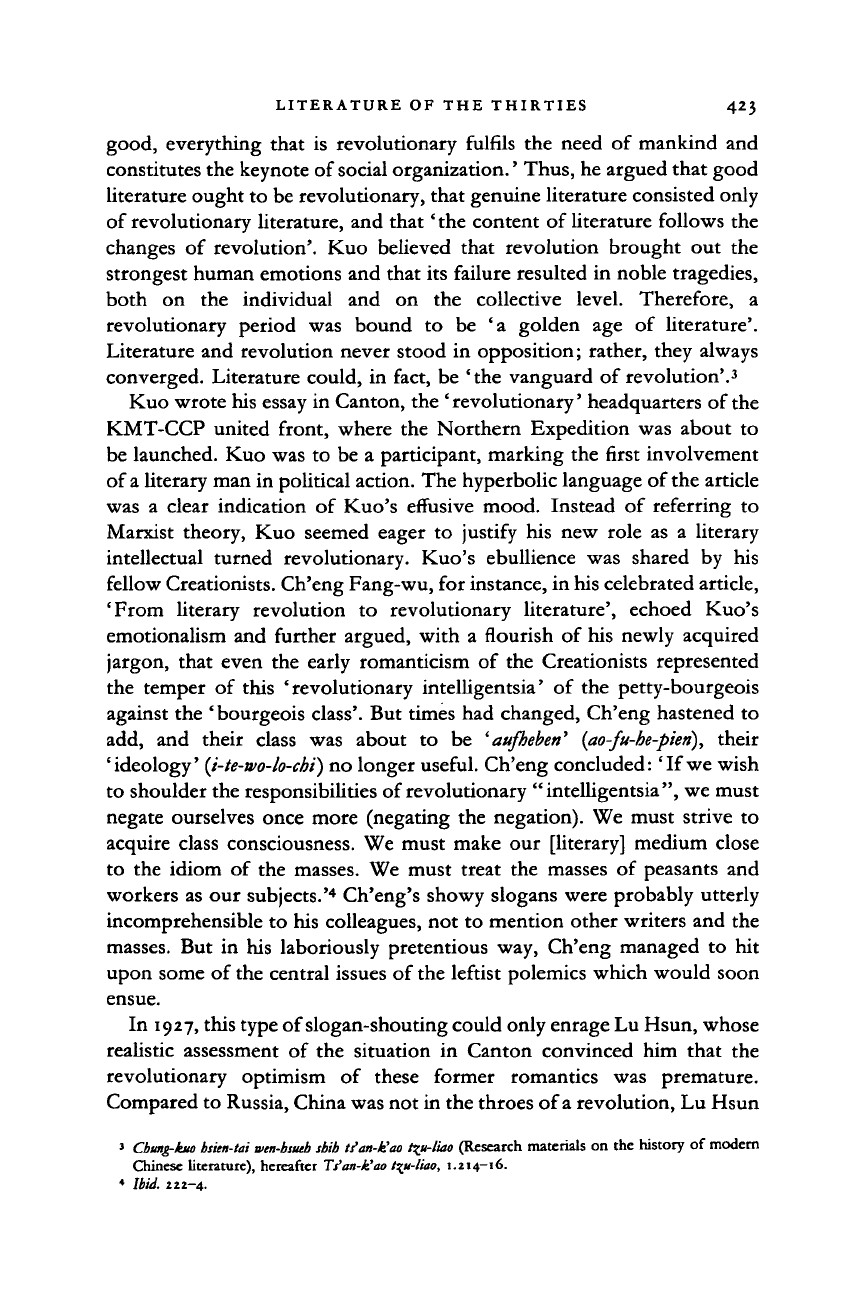
LITERATURE OF THE THIRTIES 423
good, everything that is revolutionary fulfils the need of mankind and
constitutes the keynote of social organization.' Thus, he argued that good
literature ought to be revolutionary, that genuine literature consisted only
of revolutionary literature, and that' the content of literature follows the
changes of revolution'. Kuo believed that revolution brought out the
strongest human emotions and that its failure resulted in noble tragedies,
both on the individual and on the collective level. Therefore, a
revolutionary period was bound to be 'a golden age of literature'.
Literature and revolution never stood in opposition; rather, they always
converged. Literature could, in fact, be 'the vanguard of revolution'.
3
Kuo wrote his essay in Canton, the 'revolutionary' headquarters of the
KMT-CCP united front, where the Northern Expedition was about to
be launched. Kuo was to be a participant, marking the first involvement
of
a
literary man in political action. The hyperbolic language of the article
was a clear indication of Kuo's effusive mood. Instead of referring to
Marxist theory, Kuo seemed eager to justify his new role as a literary
intellectual turned revolutionary. Kuo's ebullience was shared by his
fellow Creationists. Ch'eng Fang-wu, for instance, in his celebrated article,
'From literary revolution to revolutionary literature', echoed Kuo's
emotionalism and further argued, with a flourish of his newly acquired
jargon, that even the early romanticism of the Creationists represented
the temper of this ' revolutionary intelligentsia' of the petty-bourgeois
against the ' bourgeois class'. But times had changed, Ch'eng hastened to
add, and their class was about to be 'aufheben'
(ao-fu-he-pien),
their
'ideology'
{t-te-wo-lo-cbi)
no longer useful. Ch'eng concluded: 'If we wish
to shoulder the responsibilities of revolutionary "intelligentsia", we must
negate ourselves once more (negating the negation). We must strive to
acquire class consciousness. We must make our [literary] medium close
to the idiom of the masses. We must treat the masses of peasants and
workers as our subjects.'
4
Ch'eng's showy slogans were probably utterly
incomprehensible to his colleagues, not to mention other writers and the
masses. But in his laboriously pretentious way, Ch'eng managed to hit
upon some of the central issues of the leftist polemics which would soon
ensue.
In
1927,
this type of slogan-shouting could only enrage Lu Hsun, whose
realistic assessment of the situation in Canton convinced him that the
revolutionary optimism of these former romantics was premature.
Compared to Russia, China was not in the throes of a revolution, Lu Hsun
3
Chung-kuo
bsien-tai
wen-bsueb
sbib
ts'an-kCao
tzu-/iao (Research materials on the history of modern
Chinese literature), hereafter
T/aa-k'ao
t^u-liao, t.214-16.
4
Ibid.
222—4.
Cambridge Histories Online © Cambridge University Press, 2008
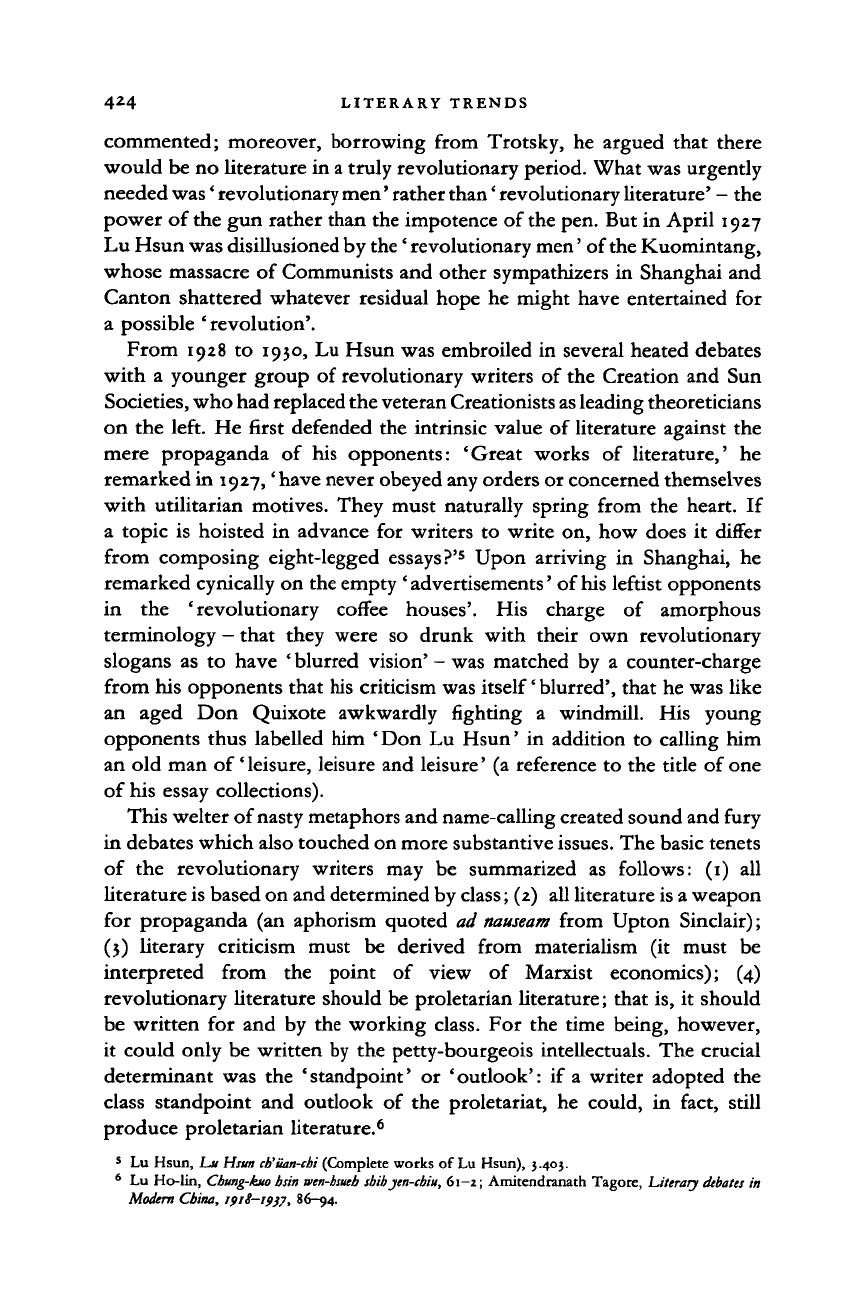
4*4 LITERARY TRENDS
commented; moreover, borrowing from Trotsky,
he
argued that there
would be no literature in
a
truly revolutionary period. What was urgently
needed was' revolutionary men' rather than' revolutionary literature'
-
the
power of the gun rather than the impotence of the pen. But in April 1927
Lu Hsun was disillusioned by the' revolutionary men' of the Kuomintang,
whose massacre of Communists and other sympathizers in Shanghai and
Canton shattered whatever residual hope he might have entertained
for
a possible ' revolution'.
From 1928
to
1930, Lu Hsun was embroiled in several heated debates
with
a
younger group of revolutionary writers of the Creation and Sun
Societies, who had replaced the veteran Creationists
as
leading theoreticians
on the left. He first defended the intrinsic value of literature against the
mere propaganda
of
his opponents: 'Great works
of
literature,'
he
remarked in 1927, 'have never obeyed any orders or concerned themselves
with utilitarian motives. They must naturally spring from the heart.
If
a topic
is
hoisted
in
advance for writers
to
write on, how does
it
differ
from composing eight-legged essays?'
5
Upon arriving
in
Shanghai,
he
remarked cynically on the empty ' advertisements' of his leftist opponents
in
the
'revolutionary coffee houses'.
His
charge
of
amorphous
terminology
-
that they were
so
drunk with their own revolutionary
slogans
as to
have ' blurred vision'
-
was matched by
a
counter-charge
from his opponents that his criticism was
itself'
blurred', that he was like
an aged
Don
Quixote awkwardly fighting
a
windmill.
His
young
opponents thus labelled him 'Don Lu Hsun'
in
addition
to
calling him
an old man of'
leisure,
leisure and leisure' (a reference to the title of one
of his essay collections).
This welter of nasty metaphors and name-calling created sound and fury
in debates which also touched on more substantive
issues.
The basic tenets
of
the
revolutionary writers may
be
summarized
as
follows:
(1) all
literature is based on and determined by class; (2) all literature is a weapon
for propaganda (an aphorism quoted ad
nauseam
from Upton Sinclair);
(j) literary criticism must
be
derived from materialism
(it
must
be
interpreted from
the
point
of
view
of
Marxist economics);
(4)
revolutionary literature should be proletarian literature; that is,
it
should
be written
for
and by the working class. For the time being, however,
it could only be written by the petty-bourgeois intellectuals. The crucial
determinant was the ' standpoint'
or
' outlook':
if
a writer adopted the
class standpoint and outlook
of
the proletariat,
he
could,
in
fact, still
produce proletarian literature.
6
s
Lu Hsun, LJI Hsun
cb'uan-cbi
(Complete works of Lu Hsun), 3.403.
6
Lu Ho-lin,
Cbung-kuo hsin wen-bsueb
shib jen-cbiu, 61-z; Amitendranath Tagote, Literary
debates
in
Modern
China,
iprS—ifj?, 86-94.
Cambridge Histories Online © Cambridge University Press, 2008

LITERATURE OF THE THIRTIES 425
These injunctions, as Chinese Communist historians later admitted,
were no more than doctrinaire formulas. In spite of their crudity and
simplicity, these tenets represented the impetuous radicalism of
a
younger
generation of self-styled Marxists such as Ch'ien Hsing-ts'un (A Ying),
Li Ch'u-li and Chu Ching-wo, and their desire to edge out the domination
of older writers on the literary scene. In their attempts to set a new literary
trend they also wanted to give a political reorientation to May Fourth
literature and to provide a theoretical framework which would henceforth
guide and shape literary creation. This imposition of a radical orthodoxy
was understandably unbearable to Lu Hsun, a man of indomitable spirit
and himself a leader of youth.
Lu Hsun's rebuttals revolved around the recurring theme of his
opponent's self-delusion: instead of boldly attacking the realities of the
KMT reaction after 1927, he argued, these revolutionary writers were still
complacently enveloped in their hollow 'revolutionary' theories. Their
pose of self-righteousness presented merely a ' fierce and ugly appearance
of extreme leftism' which veiled their ignorance of Chinese society. Lu
Hsun first criticized the simplicity of their formulas. Turning Sinclair's
phrase around, he argued in 1928 that although all literature is propaganda,
not all propaganda, and certainly not the works of these revolutionary
writers, is literature. Lu Hsun did not deny the class nature of literature,
but he strongly doubted his opponent's claim to act as spokesman for
the proletariat. The 'proletarian literature' created by a few armchair
philosophers sitting in a cafe in Shanghai, he held, certainly did not reflect
working-class demands. Lu Hsun indulged in a bit of satire:
This year, the literary ranks of Shanghai are supposed to welcome the
representatives of the proletariat. Their arrival is announced in all pomp and
circumstance. But one asks the rickshaw driver, and he says that he never pulls
any representatives... So one searches for them inside the big mansions, the
restaurants, the houses of foreigners, in bookstores and coffee houses...
7
Lu Hsun's views are clear: the urban intellectual in his sheltered bourgeois
existence had no contact with working-class life and it would be ridiculous
for him to try to adopt the standpoint of the proletariat.
This view was shared by Mao Tun, whose trilogy,
Eclipse,
was criticized
by the radical leftists for presenting a ' sick' portrait of the wrong class
from the wrong standpoint. Mao Tun described the petty-bourgeois
intellectuals' quest for idealism, their consequent vacillation and their final
disillusionment during 'revolutionary' experiences on the Northern
Expedition. In his essay, ' On Reading Ni
Huan-chih\
Mao Tun defended
this realistic novel by Yeh Shao-chun and his own fictional work, arguing
7
Lu Hsun cb'mn-cbi, 4.70-1.
Cambridge Histories Online © Cambridge University Press, 2008

4*6 LITERARY TRENDS
that
a
literary work reflecting
the
darker aspects
in the
lives
of
the
' backward' elements of the petty-bourgeoisie could still render a positive
contribution
to
the leftist cause. ' In terms
of
moving
or
educating [the
readers],
this kind
of
dark portraiture,' Mao Tun added, 'may be more
profound than those unrealistic, Utopian, and optimistic descriptions!'
8
The issue implicit in Lu Hsun's arguments but explicitly stated by Mao
Tun was
the
crucial one
of
audience: who were
the
readers
of
New
Literature?
In
his long essay written in 1928, 'From Kuling
to
Tokyo',
Mao Tun acknowledged that modern Chinese literature
in
the past six
or seven years had provided reading material only
for
educated youth,
and noted that the readership of the recent' revolutionary literature' was
even narrower. As for the labouring masses, they would never understand
it, nor would they be willing to listen even if it were fed to them. Rather
than championing the proletariat, Mao Tun wanted to enlarge the scope
of the petty-bourgeoisie both as readers and as subject matter:
Now
for
the future
of
' New
Literature'
-
or even more boldly, the future of
'revolutionary literature'
—
the first task is to move it out of youth and students
and into the petty-bourgeois masses, where
it
will then take root. In order
to
achieve this, we must first of
all
redirect our subject-matter to the lives of such
people as small merchants, middle and small peasants. We should not use too
many new terms or Europeanized sentence structures. We should not merely do
didactic propaganda of new ideas but should faithfully and forcefully depict the
essence of petty-bourgeois life.
9
Mao Tun did
in
fact carry out this injunction
in
the early thirties
in
his
novel
Midnight
and his trilogy of stories
- '
Spring silkworms', ' Autumn
harvest', and ' Winter ruin'. His fictional canvas was peopled by a variety
of petty-bourgeois characters
in
cities
and the
countryside.
The
revolutionary writers, on the contrary, offered only a meagre and slipshod
corpus of' proletarian literature', mainly by Chiang Kuang-tz'u.
Mao Tun and Lu Hsun succeeded in exposing the superficiality of the
young radicals' arguments. Mao Tun's fiction
and Lu
Hsun's
tsa-wen
demonstrated the vitality
of
critical realism. But they did not offer
an
alternative theory that was diametrically opposed
to
the radicals' canon
of revolutionary literature. Mao Tun was already
a
party member who
differed with his fellow Communists only in his more sombre assessment
of the revolution's prospects. Lu Hsun's experiences in Canton had made
him disillusioned with the revolutionary potential
of
the Kuomintang.
Circumstances under the new Nanking government further solidified his
8
Li Ho-lin,
Cbung-kuo wen-i lun-cban
(Literary debates in China), 412.
•
Ibid.
379. An English translation by Yu-shih Ch'en of this article appeared in John Berninghausen
and Ted Huters, eds.
Revolutionary literature
in
Cbina:
an
antboloff,
37—44. The editors have also
supplied
a
perceptive introductory essay.
Cambridge Histories Online © Cambridge University Press, 2008
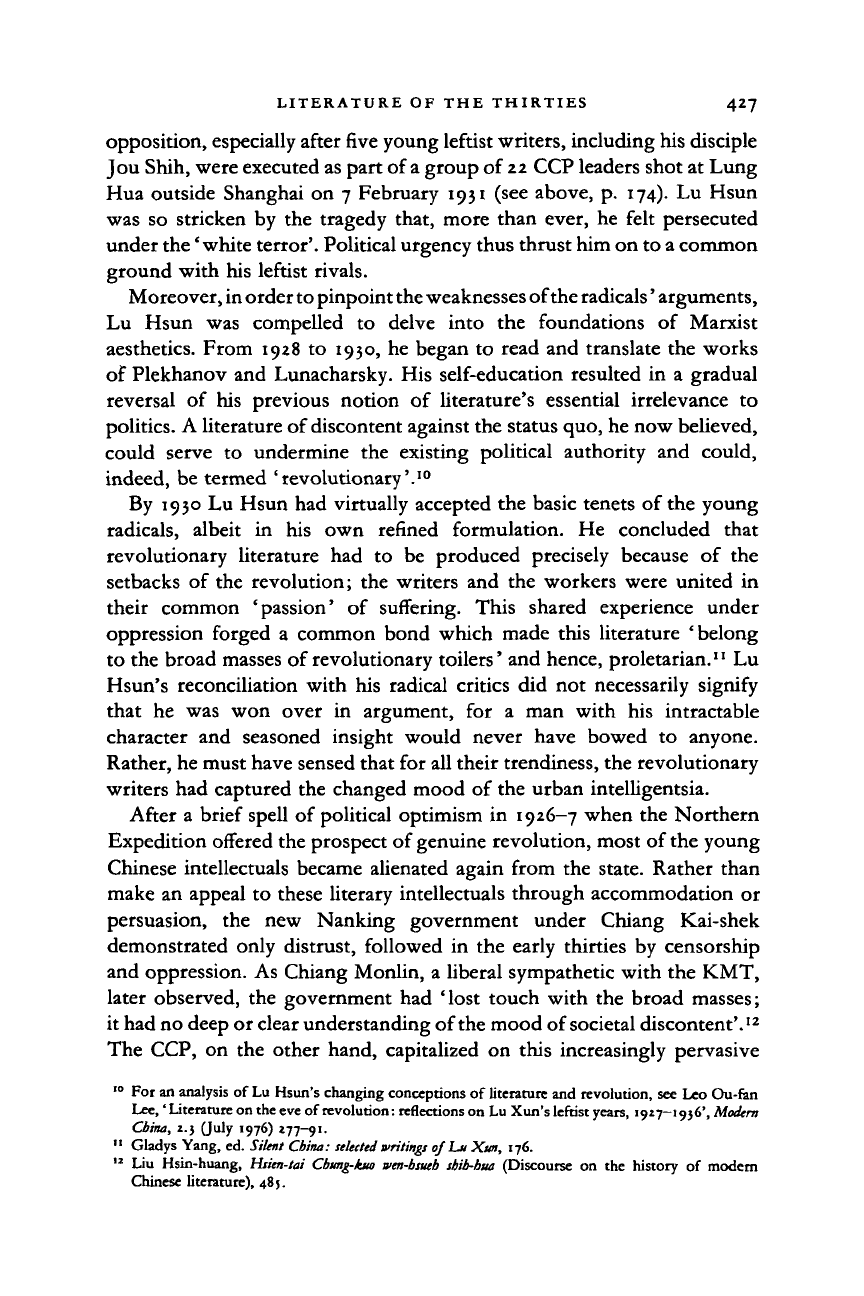
LITERATURE OF THE THIRTIES 427
opposition, especially after five young leftist writers, including his disciple
Jou Shih, were executed as part of a group of
22
CCP leaders shot at Lung
Hua outside Shanghai on 7 February 1931 (see above, p. 174). Lu Hsun
was so stricken by the tragedy that, more than ever, he felt persecuted
under the 'white terror'. Political urgency thus thrust him on to a common
ground with his leftist rivals.
Moreover, in order to pinpoint the weaknesses of the
radicals'
arguments,
Lu Hsun was compelled to delve into the foundations of Marxist
aesthetics. From 1928 to 1930, he began to read and translate the works
of Plekhanov and Lunacharsky. His self-education resulted in a gradual
reversal of his previous notion of literature's essential irrelevance to
politics. A literature of discontent against the status quo, he now believed,
could serve to undermine the existing political authority and could,
indeed, be termed 'revolutionary'.
10
By 1930 Lu Hsun had virtually accepted the basic tenets of the young
radicals, albeit in his own refined formulation. He concluded that
revolutionary literature had to be produced precisely because of the
setbacks of the revolution; the writers and the workers were united in
their common 'passion' of suffering. This shared experience under
oppression forged a common bond which made this literature 'belong
to the broad masses of revolutionary toilers' and hence, proletarian.
11
Lu
Hsun's reconciliation with his radical critics did not necessarily signify
that he was won over in argument, for a man with his intractable
character and seasoned insight would never have bowed to anyone.
Rather, he must have sensed that for all their trendiness, the revolutionary
writers had captured the changed mood of the urban intelligentsia.
After a brief spell of political optimism in 1926-7 when the Northern
Expedition offered the prospect of genuine revolution, most of the young
Chinese intellectuals became alienated again from the state. Rather than
make an appeal to these literary intellectuals through accommodation or
persuasion, the new Nanking government under Chiang Kai-shek
demonstrated only distrust, followed in the early thirties by censorship
and oppression. As Chiang Monlin, a liberal sympathetic with the KMT,
later observed, the government had 'lost touch with the broad masses;
it had no deep or clear understanding of the mood of societal discontent'.
12
The CCP, on the other hand, capitalized on this increasingly pervasive
10
For an analysis of Lu Hsun's changing conceptions of literature and revolution, see Leo Ou-fan
Lee,'Literature on the eve of revolution: reflections on Lu Xun's leftist years, 1927—1936', Modern
China, 2.3 (July 1976) 177-91.
" Gladys Yang, ed. Silent China:
selected
writings of Lu Xun, 176.
12
Liu Hsin-huang, Hsien-tai Chung-kuo wen-bsueb sbib-hua (Discourse on the history of modern
Chinese literature), 48
j.
Cambridge Histories Online © Cambridge University Press, 2008
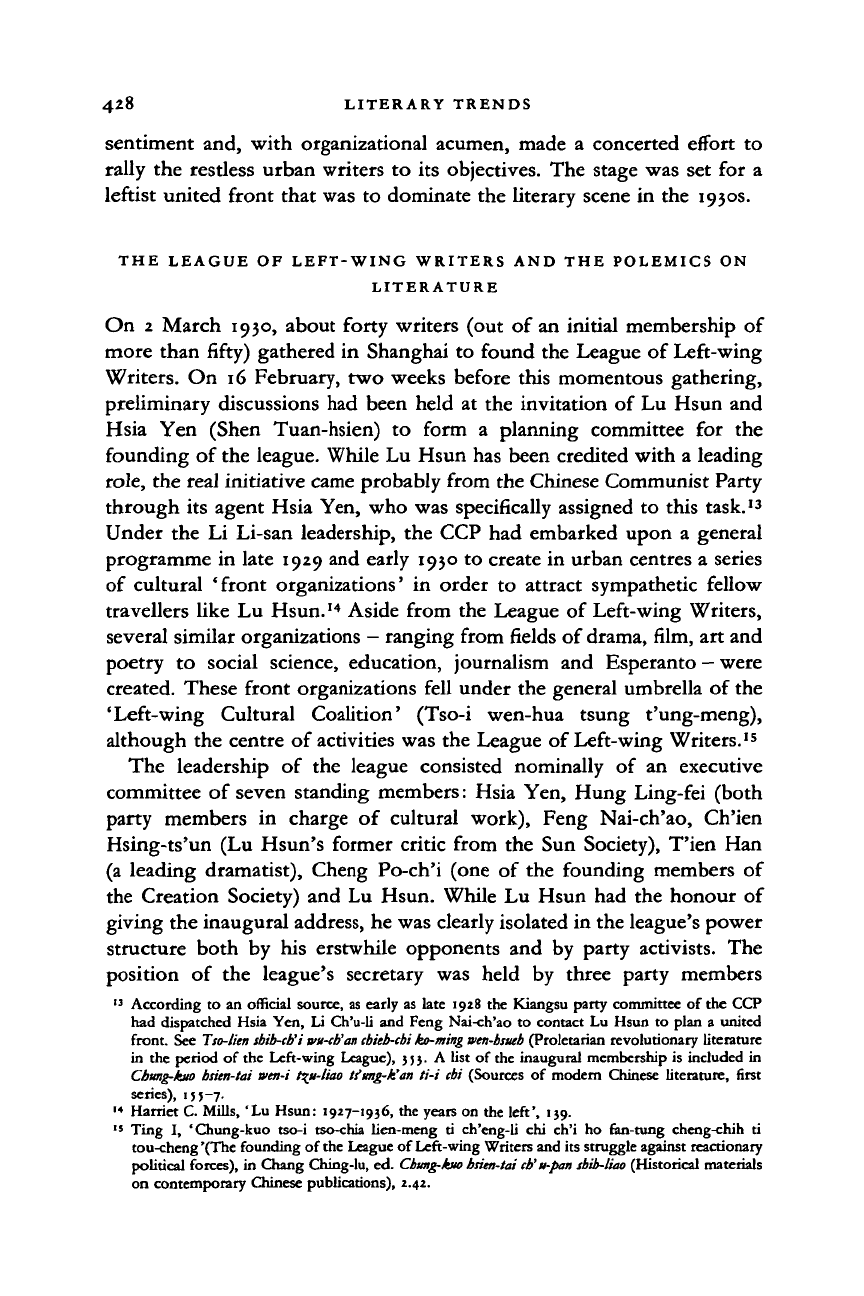
428 LITERARY TRENDS
sentiment and, with organizational acumen, made a concerted effort to
rally the restless urban writers to its objectives. The stage was set for a
leftist united front that was to dominate the literary scene in the 1930s.
THE LEAGUE OF LEFT-WING WRITERS AND THE POLEMICS ON
LITERATURE
On 2 March 1930, about forty writers (out of an initial membership of
more than fifty) gathered in Shanghai to found the League of Left-wing
Writers. On 16 February, two weeks before this momentous gathering,
preliminary discussions had been held at the invitation of Lu Hsun and
Hsia Yen (Shen Tuan-hsien) to form a planning committee for the
founding of the league. While Lu Hsun has been credited with a leading
role,
the real initiative came probably from the Chinese Communist Party
through its agent Hsia Yen, who was specifically assigned to this task.
13
Under the Li Li-san leadership, the CCP had embarked upon a general
programme in late 1929 and early 1930 to create in urban centres a series
of cultural 'front organizations' in order to attract sympathetic fellow
travellers like Lu Hsun.
14
Aside from the League of Left-wing Writers,
several similar organizations
—
ranging from fields of drama, film, art and
poetry to social science, education, journalism and Esperanto - were
created. These front organizations fell under the general umbrella of the
'Left-wing Cultural Coalition' (Tso-i wen-hua tsung t'ung-meng),
although the centre of activities was the League of Left-wing Writers.
15
The leadership of the league consisted nominally of an executive
committee of seven standing members: Hsia Yen, Hung Ling-fei (both
party members in charge of cultural work), Feng Nai-ch'ao, Ch'ien
Hsing-ts'un (Lu Hsun's former critic from the Sun Society), T'ien Han
(a leading dramatist), Cheng Po-ch'i (one of the founding members of
the Creation Society) and Lu Hsun. While Lu Hsun had the honour of
giving the inaugural address, he was clearly isolated in the league's power
structure both by his erstwhile opponents and by party activists. The
position of the league's secretary was held by three party members
13
According to an official source, as early as late 1928 the Kiangsu party committee of the CCP
had dispatched Hsia Yen, Li Ch'u-li and Feng Nai-ch'ao to contact Lu Hsun to plan a united
front. See
Tso-lien sbib-cb'i vu-cb'an cbieb-cbi ko-ming wen-bsutb
(Proletarian revolutionary literature
in the period of the Left-wing League), 3)3. A list of the inaugural membership is included in
Cbmg-kuo
bsien-tai men-i
t^u-liao
ttung-k'an
ti-i cbi (Sources of modern Chinese literature, first
series), 155-7.
14
Harriet C. Mills, 'Lu Hsun: 1927-1936, the years on the left', 139.
15
Ting I, 'Chung-kuo tso-i tso-chia lien-meng ti ch'eng-li chi ch'i ho fan-tung cheng-chih ti
tou-cheng '(The founding of
the
League of Left-wing Writers and its struggle against reactionary
political forces), in Chang Ching-lu, ed.
Cbimg-km bsien-tai cb'u-pan sbib-liao
(Historical materials
on contemporary Chinese publications), 2.42.
Cambridge Histories Online © Cambridge University Press, 2008
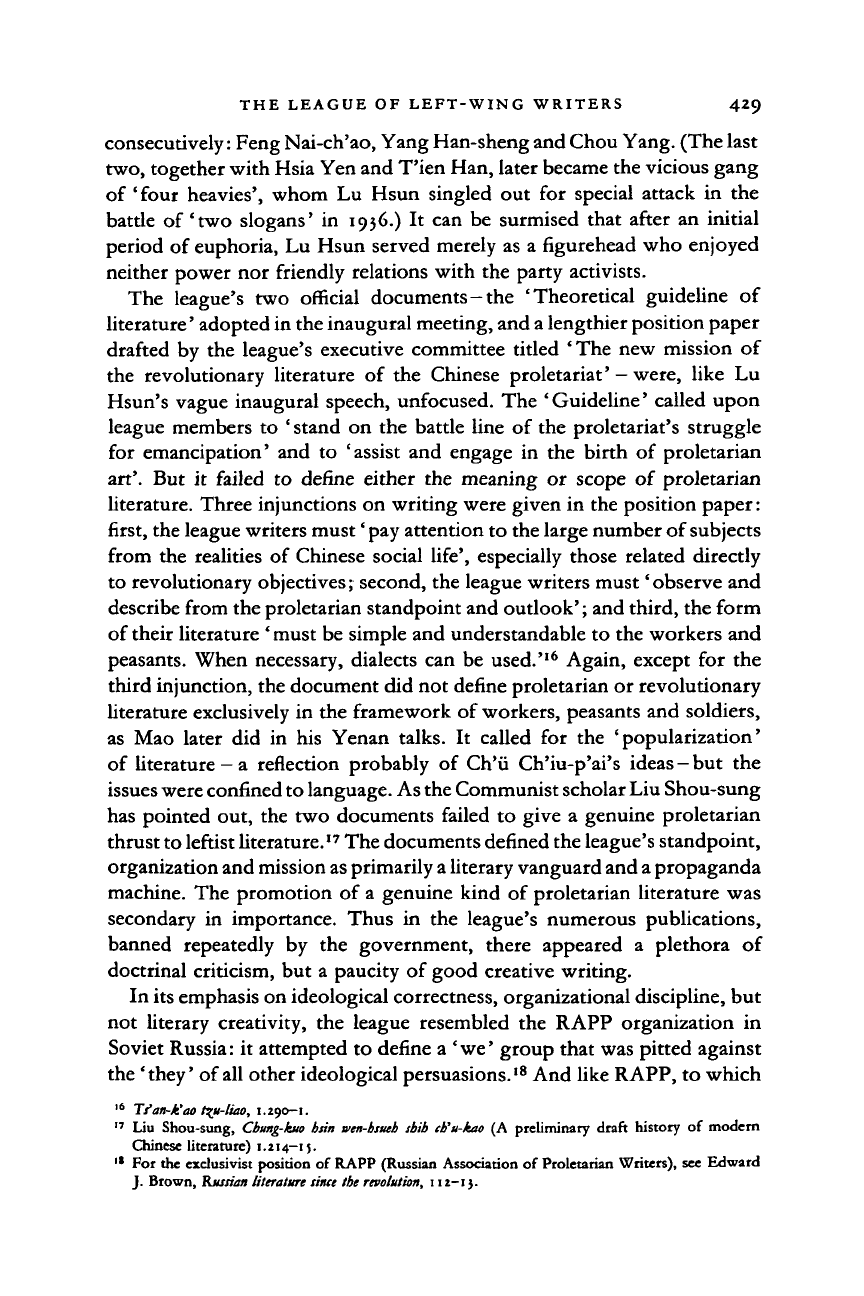
THE LEAGUE OF LEFT-WING WRITERS 429
consecutively: Feng Nai-ch'ao, Yang Han-sheng and Chou Yang. (The last
two,
together with Hsia Yen and T'ien Han, later became the vicious gang
of ' four heavies', whom Lu Hsun singled out for special attack in the
battle of 'two slogans' in 1936.) It can be surmised that after an initial
period of euphoria, Lu Hsun served merely as a figurehead who enjoyed
neither power nor friendly relations with the party activists.
The league's two official documents - the 'Theoretical guideline of
literature' adopted in the inaugural meeting, and a lengthier position paper
drafted by the league's executive committee titled 'The new mission of
the revolutionary literature of the Chinese proletariat' - were, like Lu
Hsun's vague inaugural speech, unfocused. The 'Guideline' called upon
league members to ' stand on the battle line of the proletariat's struggle
for emancipation' and to 'assist and engage in the birth of proletarian
art'. But it failed to define either the meaning or scope of proletarian
literature. Three injunctions on writing were given in the position paper:
first, the league writers must 'pay attention to the large number of subjects
from the realities of Chinese social life', especially those related directly
to revolutionary objectives; second, the league writers must' observe and
describe from the proletarian standpoint and outlook'; and third, the form
of their literature ' must be simple and understandable to the workers and
peasants. When necessary, dialects can be used.'
16
Again, except for the
third injunction, the document did not define proletarian or revolutionary
literature exclusively in the framework of workers, peasants and soldiers,
as Mao later did in his Yenan talks. It called for the 'popularization'
of literature - a reflection probably of Ch'ii Ch'iu-p'ai's ideas - but the
issues
were confined to
language.
As
the Communist scholar Liu Shou-sung
has pointed out, the two documents failed to give a genuine proletarian
thrust to leftist literature.
I7
The documents defined the league's standpoint,
organization and mission as primarily
a
literary vanguard and a propaganda
machine. The promotion of a genuine kind of proletarian literature was
secondary in importance. Thus in the league's numerous publications,
banned repeatedly by the government, there appeared a plethora of
doctrinal criticism, but a paucity of good creative writing.
In its emphasis on ideological correctness, organizational discipline, but
not literary creativity, the league resembled the RAPP organization in
Soviet Russia: it attempted to define a ' we' group that was pitted against
the 'they' of
all
other ideological persuasions.
18
And like RAPP, to which
16
Tfan-k'ao t^u-liao, i.290-1.
17
Liu Shou-sung, Cbung-kuo bsin atn-bsueh sbib cb'u-kao (A preliminary draft history of modern
Chinese literature) 1.214-15.
" For the exclusivist position of RAPP (Russian Association of Proletarian Writers), see Edward
J. Brown, Russian literature
since
the revolution, 112-13.
Cambridge Histories Online © Cambridge University Press, 2008
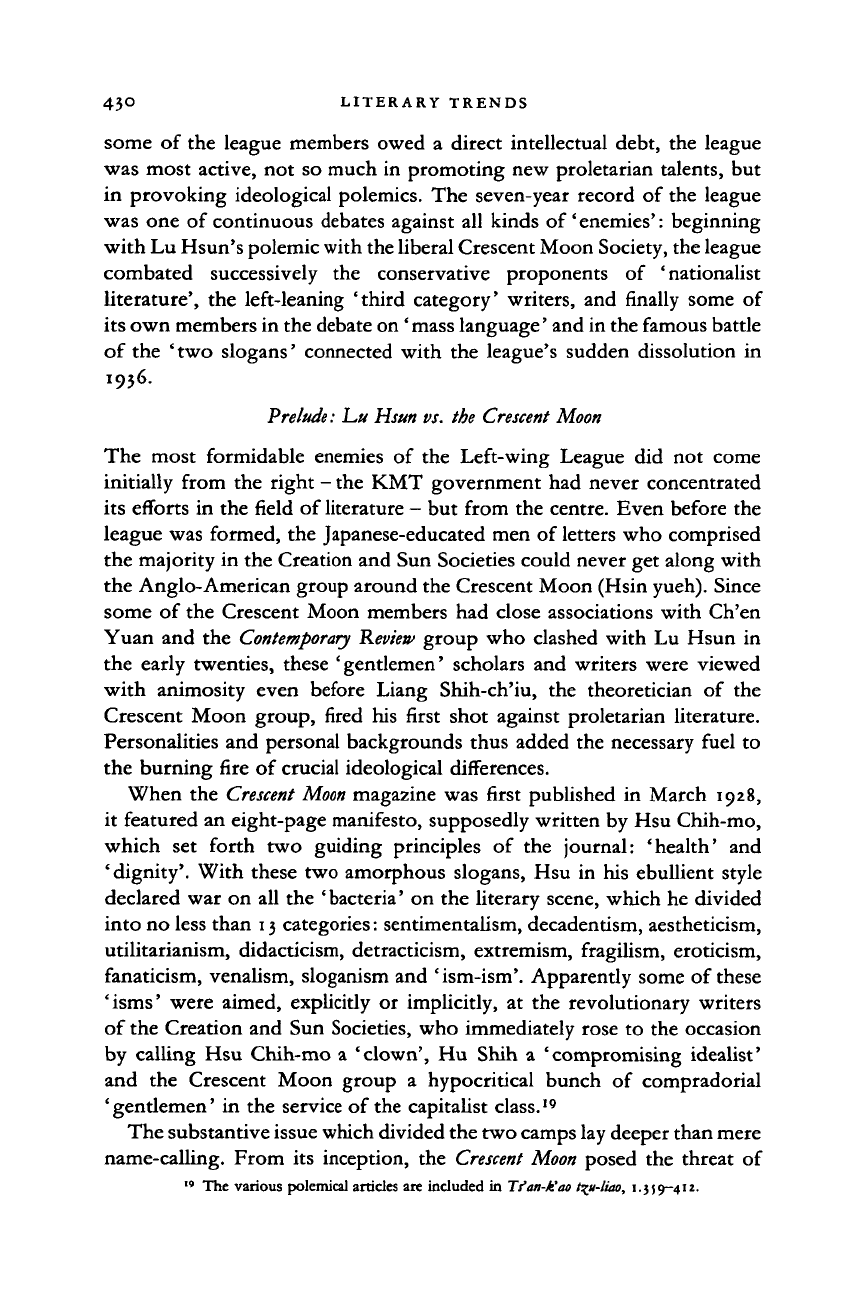
43° LITERARY TRENDS
some
of
the league members owed
a
direct intellectual debt,
the
league
was most active,
not so
much
in
promoting new proletarian talents,
but
in provoking ideological polemics.
The
seven-year record
of
the league
was
one
of
continuous debates against
all
kinds
of
'
enemies':
beginning
with Lu Hsun's polemic with the liberal Crescent Moon Society, the league
combated successively
the
conservative proponents
of
'nationalist
literature',
the
left-leaning 'third category' writers,
and
finally some
of
its own members in the debate on'
mass
language' and in the famous battle
of
the
' two slogans' connected with
the
league's sudden dissolution
in
1956.
Prelude:
L.U
Hsun
vs. the
Crescent Moon
The most formidable enemies
of
the
Left-wing League
did not
come
initially from
the
right
-
the KMT government
had
never concentrated
its efforts
in the
field
of
literature
-
but
from
the
centre. Even before
the
league was formed,
the
Japanese-educated men
of
letters who comprised
the majority
in
the Creation and Sun Societies could never get along with
the Anglo-American group around the Crescent Moon (Hsin yueh). Since
some
of
the Crescent Moon members
had
close associations with Ch'en
Yuan
and the
Contemporary Review
group
who
clashed with
Lu
Hsun
in
the early twenties, these 'gentlemen' scholars
and
writers were viewed
with animosity even before Liang Shih-ch'iu,
the
theoretician
of the
Crescent Moon group, fired
his
first shot against proletarian literature.
Personalities
and
personal backgrounds thus added
the
necessary fuel
to
the burning fire
of
crucial ideological differences.
When
the
Crescent Moon
magazine
was
first published
in
March
1928,
it featured
an
eight-page manifesto, supposedly written
by
Hsu Chih-mo,
which
set
forth
two
guiding principles
of the
journal: 'health'
and
'dignity'. With these two amorphous slogans,
Hsu
in
his
ebullient style
declared
war on all the
' bacteria'
on the
literary scene, which
he
divided
into no less than 13 categories: sentimentalism, decadentism, aestheticism,
utilitarianism, didacticism, detracticism, extremism, fragilism, eroticism,
fanaticism, venalism, sloganism and
'
ism-ism'.
Apparently some
of
these
'isms'
were aimed, explicitly
or
implicitly,
at
the
revolutionary writers
of the Creation
and Sun
Societies, who immediately rose
to
the
occasion
by calling
Hsu
Chih-mo
a
'clown',
Hu
Shih
a
'compromising idealist'
and
the
Crescent Moon group
a
hypocritical bunch
of
compradorial
'gentlemen'
in
the
service
of
the capitalist class.
19
The substantive issue which divided the two camps lay deeper than mere
name-calling. From
its
inception,
the
Crescent Moon
posed
the
threat
of
" The various polemical articles are included
in
Tfan-k'ao
t^u-liao,
i.359-412.
Cambridge Histories Online © Cambridge University Press, 2008
